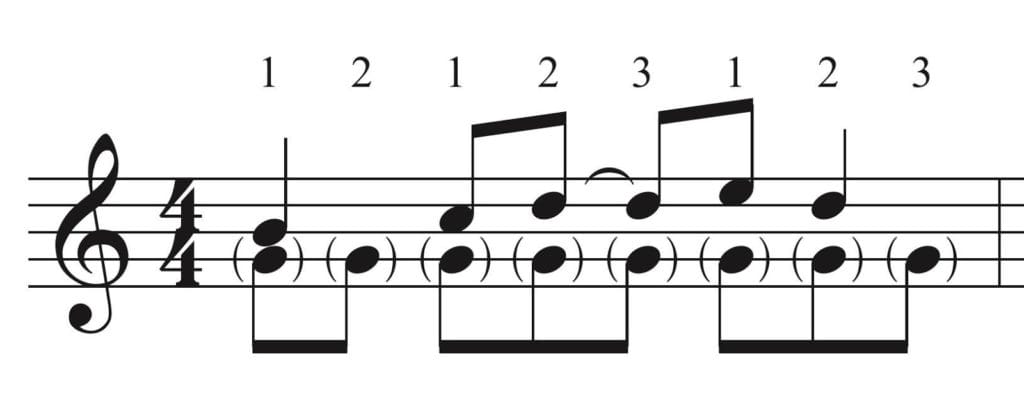We’ve all had to learn a passage of music where the rhythm seemed simply impossible to nail – maybe it was in a bizarre time signature, or perhaps there were indecipherable flurries of sixteenth notes and rests that were hard on both the eyes and the hands.
Though complex rhythms are one of the most initially intimidating elements we come across when learning music, if you sit with them for a little bit, you’ll notice you can break them down into smaller components to better understand and play the tricky passages.
There are several ways to simplify complex rhythms, and one of the most versatile ones is to reduce them into groups of 2’s and 3’s. This is not meant to replace regular counting, but rather act as an additional tool to help you quickly and easily internalize challenging rhythms.
By the end of this article, you’ll understand how to apply this method of subdivision to a variety of simple and complex time signatures in order to internalize, read, and play through seemingly-complicated meters, beats, and patterns.
The overview and math (I promise not too much of either!)
One of the most perplexing time signatures I encounter from time to time is “1 over something” – i.e. 1/4, 1/8, 1/16, etc. Rhythmic diversity is very important in music, but there really is no such thing as “1 over something” in rhythm. Every beat is just a sound, an isolated sonority, when it is alone. It only means something when placed in context with another beat. So, there really is no “1” – there really is only “1 + something”.
 If you’re confused, I completely understand. What I am saying, in short, is that every beat needs another beat to give the first beat meaning in a rhythm. If you see a quarter note, does it really matter if it is a quarter note unless there are other notes? Even if it is given a tempo, it still has no rhythmic meaning alone. It is just one sound.
If you’re confused, I completely understand. What I am saying, in short, is that every beat needs another beat to give the first beat meaning in a rhythm. If you see a quarter note, does it really matter if it is a quarter note unless there are other notes? Even if it is given a tempo, it still has no rhythmic meaning alone. It is just one sound.
However, if you have more than one note, you have a rhythm instead of a single sound. So, the smallest rhythm is really “1 + 1,” or “2”.
Why does all of this matter?
A great way to figure out tough rhythms, whether you are singing, playing, writing, conducting, or clapping along with music, is to subdivide them into smaller components.
We subdivide by finding the smallest rhythmic element that is present in a passage, and then thinking of everything in terms of that element.
For example, in an imaginary piece in 4/4 time, each note in a melody of quarter notes and eighth notes can be subdivided into eighth notes. Similarly, each note in a melody of half notes and quarter notes can be subdivided into quarter notes.
What is the correct subdivision to use in these passages?

Show answer
A: Eighth note; B: Quarter note; C: Sixteenth note; D: Sixteenth note
But once you have it all broken down, how do you make sense of all these small subdivisions? The approach to subdivision that I am writing about here is breaking every rhythm into 2’s and 3’s – or subdividing everything into groups of 2’s and 3’s.
Why use 2’s and 3’s?
2 is the smallest grouping we can use to subdivide things. However, you will only get even rhythms and meters if you keep adding 2’s together. This leaves out odd meters such as 5/4, 7/8, or even the basic meter of 3/4. So, to read both even and odd meters, you will need to have 2’s and 3’s – adding 2’s and/or 3’s can make any other number.
Okay, enough math. Let’s dig in and break everything down into 2’s and 3’s, to give you some tools to tackle those tough rhythms.
Basic application of 2’s and 3’s: Meter
Let’s start simple. How about reading 4/4?
4/4 does mean four quarter notes in a measure. But, 4/4 is not really 1 + 1 + 1 + 1; it is usually felt in 2, with either an accent on beats 1 and 3, or on beats 2 and 4:

If we break 4/4 into two parts of 2, we can see the rhythms clearer. Take these two passages that look different, but are actually the same music:

The beats of 4/4 are more clearly shown in example B, by using a tie to expose beat 3 (the second, tied “D”). Showing all of the beats helps us feel the pulse, and in turn helps us more easily understand the rhythm. To test this, try keeping a steady pulse going (e.g. on your lap, as a clap, or with your foot) and say/sing the melody in A. Then, do the same with the melody in B. Professional musicians prefer B because it shows the beats, and helps align the melody with the tempo and meter they are using.
But what if you still cannot get the rhythm? You can break down rhythm B into groups of two and three eighth notes:

By not only dividing the notes into 2’s and 3’s, but also feeling them when you play the passage, you can more easily grasp the rhythm. Sound it out in your head, clap it aloud, or sing it – it will come naturally after some trying.
More Meter Practice
Try using this subdivision method with some simple time signatures.
3/4
3/4 is a pretty simple meter since it easily fits the basic rhythmic groupings:

Let’s work out an example in 3/4. Here is the passage:

First, let’s think of everything in terms of 3’s, just like the meter:

However, that may not help us learn the rhythm completely. Let’s subdivide each of those three beats into 2’s:

With every eighth note accounted for, we use a pulse of two eighth notes to ensure we know where each rhythm of each beat lies.
6/8
6/8 is either 3 + 3, or 2 (depending on how you feel it). It can be 1-2-3 + 1-2-3 (the same as 1-2-3 + 4-5-6), or 1 + 1 (if you feel the entire measure as if it is in two parts; this is common at faster tempos):

Take this example. Here we have a bar in 6/8, first divided into two groups of three eighth notes for a 3 + 3 feeling (top picture), and secondly divided into two groups without subdividing in eighth notes (bottom picture):


Listen to Jethro Tull’s song “Thick as a Brick”, and try feeling it in both 3 + 3 and in 2:
The music switches between these two. It has a few other meters in it, so make sure to listen for the 6/8 when it is there, and know when it is not there. The song’s 6/8 sections may even be felt in 3/4. The feeling of three beats (3/4) in 6/8 is a common musical rhythm called a hemiola – keep your ears open for hemiolas in other works in 6/8.

Intermediate Application of 2’s and 3’s: Odd Time Signatures
Every odd time signature can be broken into groups of 2’s and 3’s. Take 5/4 – it is always going to be 2 + 3 or 3 + 2:

Try listening to Dave Brubeck’s famous work in 5/4, “Take 5”. Count the beat in groups of 3 + 2 or 2 + 3. Play games with the pulse by switching between feeling it in 3 + 2 and 2 + 3:
7/8 is always either 2 + 2 + 3 or 3 + 2 + 2, or less commonly 2 + 3 + 2:

Advanced Meter Practice
How about combining two time signatures, such as 4/4 + 3/8? Think of it in eighth notes: 2 + 2 + 2 + 2 + 3, with the “2 + 2 + 2 + 2” representing 4/4 time, and the “+ 3” representing 3/8:

How about a time signature of 15/16? Think of it in 16th notes: 2 + 2 + 2 + 2 + 2 + 2 + 3. At faster tempos it may blur into 2/4 + 2/8 + 3/16:

To help master this, I recommend figuring out the rhythms to Rush’s song “Driven”. Not only does it use odd meters, but it changes between them constantly:
Once you’ve worked through one phrase, watch out! Many times the repeat of a phrase is not an identical repeat. The band plays tricks on us by changing the music the second time around in many places.
Advanced Application of 2’s and 3’s: Syncopation and Other Complex Rhythms
Now that you have seen the complex ways in which meters can be subdivided, try applying this more closely to the rhythms inside them.
One application is syncopation: the emphasis of beats that are not native to a meter. Syncopation most commonly begins with a grouping of 3 in a meter that has an emphasis on groupings of 2. Our first example demonstrated this nicely:

We know that 4/4 has emphasized beats on 1 and 3, or on 2 and 4. As we see (again, much clearer in example B), beat 3 is hidden in a tied D note. We don’t hear beat 3 because it is sustained from beat 2 as the D note. So, we hear beats 1, 2, and 4, but the rhythm throws us off of beat 3. This is syncopation. As we see, we subdivide the rhythm just as before:

Let’s crank it up a notch with this example. Find the smallest unit, and use it to divide the rest of the rhythm up into 2’s and 3’s:

Show answer

You may notice that it is best to take this approach slow at first, and then speed up the tempo. This is also a very tricky passage rhythmically (which is precisely why we are examining it). In addition, there are multiple ways to divide the first two measures: you can swap out some 2’s and 3’s for 3’s or 2’s, depending on how you want to feel the music. You may also notice that not only is everything divided into 2’s and 3’s, but the last three beats of bar 2, and the whole note in bar 3, are broken into larger groups of 3’s and 2’s, to make things easier than counting a series of sixteenth note groupings of 2.
Here is another example – use the same method as above to divide the following into 2’s and 3’s:

Show answer

Here is a final example; this one is a bit tricky because of the other musical markings and ornaments involved:

Show answer

Repertoire lists for reinforcing your skills
Here is a list of repertoire in certain meters to get you started. Please note that some of these songs have mixed meter, but the “mixed meter” category has the songs to specifically examine closely for learning this.
Try feeling everything in these pieces in groups of 2’s and 3’s:
- 4/4:
- “Feels Like the First Time” – Foreigner
- “Symphony No. 5 in C Minor, Op. 67: 1. Allegro” – Ludwig van Beethoven
- “Always and Forever” – Pat Metheny Group
- “Rocket Man” – Elton John
- 3/4:
- “Waltz No. 1 in E-Flat, Op. 18” – Frederic Chopin
- “Manic Depression” – Jimi Hendrix
- “La Valse” – Maurice Ravel
- 6/8:
- “Somebody to Love” – Queen
- “Great Blue Sea” – The Reign of Kindo (watch out for the hemiolas!)
- “The Things (That) I Used to Do” – Stevie Ray Vaughan
- 5/4:
- “Mission Impossible Theme” – Lalo Schifrin
- “15 Step” – Radiohead
- 7/4:
- “Money” – Pink Floyd
- Mixed meter (more than one meter in a piece):
- “Strawberry Fields Forever” – The Beatles
- “Black” – Pearl Jam (the chorus shifts the beat around, which can confuse things)
- “A Life Left Behind” – Dream Theater (mixed meter and changing beat emphasis)
Simplifying by Subdivision
I realize that for most people, including music professionals, this is a complete re-envisioning of the basic methods of counting we all are taught and take for granted. This 2’s and 3’s method takes a long time to internalize, and is not intended to replace counting; rather, it is an additional tool to help figure out rhythms in music more efficiently and effectively. This is a very simple overview of this approach, and the examples given are only for starters. There are countless other ways you can apply this.
Future expansions on this could cover tuplets (notes that fit inside other notes), polyrhythms (two simultaneous rhythmic patterns), and polymeters (two simultaneous meters). The possibilities are endless.
For now, work through figuring out the rhythms in the examples provided above! Start simple. Work things out on paper. Stop after a half hour, then come back later in the day to see if you remember how things went, and if you can figure things out again from scratch.
And of course, enjoy the “Eureka!” moments along the way, as you learn to recognize patterns of 2’s and 3’s that occur in music, and how they help guide the rhythm and feel of the piece.
Happy subdividing!
Even the most complicated rhythms can be broken down into basic building blocks. What are some strategies that you use to internalize, play, and sing tricky rhythms and melodies?
The post Counting Music in 2’s and 3’s appeared first on Musical U.
